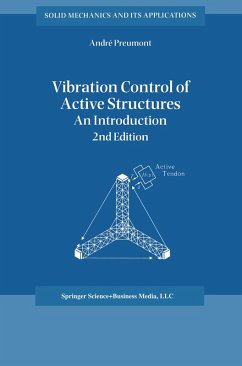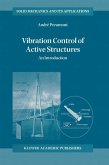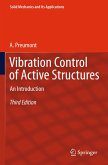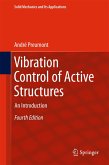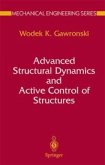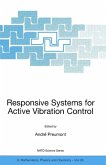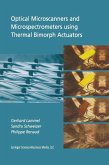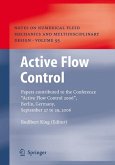

Alle Infos zum eBook verschenken

- Format: PDF
- Merkliste
- Auf die Merkliste
- Bewerten Bewerten
- Teilen
- Produkt teilen
- Produkterinnerung
- Produkterinnerung

Hier können Sie sich einloggen

Bitte loggen Sie sich zunächst in Ihr Kundenkonto ein oder registrieren Sie sich bei bücher.de, um das eBook-Abo tolino select nutzen zu können.
My objective in writing this book was to cross the bridge between the structural dynamics and control communities, while providing an overview of the potential of SMART materials for sensing and actuating purposes in active vibration c- trol. I wanted to keep it relatively simple and focused on systems which worked. This resulted in the following: (i) I restricted the text to fundamental concepts and left aside most advanced ones (i.e. robust control) whose usefulness had not yet clearly been established for the application at hand. (ii) I promoted the use of collocated actuator/sensor pairs…mehr
- Geräte: PC
- ohne Kopierschutz
- eBook Hilfe
- Größe: 21.22MB
![Vibration Control of Active Structures (eBook, PDF) Vibration Control of Active Structures (eBook, PDF)]() A. PreumontVibration Control of Active Structures (eBook, PDF)40,95 €
A. PreumontVibration Control of Active Structures (eBook, PDF)40,95 €![Vibration Control of Active Structures (eBook, PDF) Vibration Control of Active Structures (eBook, PDF)]() A. PreumontVibration Control of Active Structures (eBook, PDF)40,95 €
A. PreumontVibration Control of Active Structures (eBook, PDF)40,95 €![Vibration Control of Active Structures (eBook, PDF) Vibration Control of Active Structures (eBook, PDF)]() André PreumontVibration Control of Active Structures (eBook, PDF)53,95 €
André PreumontVibration Control of Active Structures (eBook, PDF)53,95 €![Advanced Structural Dynamics and Active Control of Structures (eBook, PDF) Advanced Structural Dynamics and Active Control of Structures (eBook, PDF)]() Wodek GawronskiAdvanced Structural Dynamics and Active Control of Structures (eBook, PDF)177,95 €
Wodek GawronskiAdvanced Structural Dynamics and Active Control of Structures (eBook, PDF)177,95 €![Responsive Systems for Active Vibration Control (eBook, PDF) Responsive Systems for Active Vibration Control (eBook, PDF)]() Responsive Systems for Active Vibration Control (eBook, PDF)40,95 €
Responsive Systems for Active Vibration Control (eBook, PDF)40,95 €![Optical Microscanners and Microspectrometers using Thermal Bimorph Actuators (eBook, PDF) Optical Microscanners and Microspectrometers using Thermal Bimorph Actuators (eBook, PDF)]() Gerhard LammelOptical Microscanners and Microspectrometers using Thermal Bimorph Actuators (eBook, PDF)113,95 €
Gerhard LammelOptical Microscanners and Microspectrometers using Thermal Bimorph Actuators (eBook, PDF)113,95 €![Active Flow Control (eBook, PDF) Active Flow Control (eBook, PDF)]() Active Flow Control (eBook, PDF)161,95 €
Active Flow Control (eBook, PDF)161,95 €-
-
-
Dieser Download kann aus rechtlichen Gründen nur mit Rechnungsadresse in A, B, BG, CY, CZ, D, DK, EW, E, FIN, F, GR, HR, H, IRL, I, LT, L, LR, M, NL, PL, P, R, S, SLO, SK ausgeliefert werden.
- Produktdetails
- Verlag: Springer Netherlands
- Seitenzahl: 368
- Erscheinungstermin: 11. April 2006
- Englisch
- ISBN-13: 9780306484223
- Artikelnr.: 44175929
- Verlag: Springer Netherlands
- Seitenzahl: 368
- Erscheinungstermin: 11. April 2006
- Englisch
- ISBN-13: 9780306484223
- Artikelnr.: 44175929
- Herstellerkennzeichnung Die Herstellerinformationen sind derzeit nicht verfügbar.
"The third edition of the textbook should serve as an outstanding updated reference book for structural engineers, automation professionals, students, and also for general readers interested in this emerging subject." (Lubomír Bakule, zbMATH, Vol. 1273, 2013)
From the second edition:
"This is a very useful book for graduate students, researchers and professionals interested in strucutrasl control. I highly recommend it."
(AIAA Journal, 41:3)
Zentralblatt MATH, 910 (1999)
`The book is written in a very easy and interesting style and has a good set of problems at the end of each chapter. This reviewer enjoyed reading the book and would recommend it for any graduate course on control of structures. This book occupies a unique place in the set of references in this important field.'
Mechatronics, 10 (2000)
